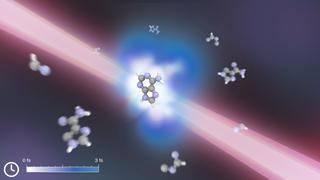Ultrafast lasers can protect a DNA building block from light-induced dissociation
An international research team led by CFEL researcher Francesca Calegari and with the key participation of the Max Planck Institute for the Structure and Dynamics of Matter (MPSD) has demonstrated that ultrashort laser pulses can be used to protect one of the DNA building blocks against destruction induced by vacuum ultraviolet (VUV) radiation. The research group unveiled that a second laser flash in the infrared, timed shortly (only a few millionths of billions of a second) after the first VUV flash, prevented the adenine molecule to disintegrate, therefore stabilizing it. The group presents their work in the journal Communications Chemistry published by Nature publishing group.
Artist´s impression of the ultrafast stabilization of adenine against dissociation: When the molecule is ionized by VUV radiation it undergoes dissociation, however by taking advantage of a charge migration mechanism and by properly timing a second infrared laser pulse it is possible to stabilize it via a second ionization event. Graphics: U. De Giovannini MPSD
High energy radiation can cause irreparable damage to our own biological molecules – such as DNA – leading to mutations and potentially cell death. Damage is often occurring as a consequence of the molecular ionization, inducing the fragmentation of the DNA subunits. So far, protection against radiation damage has hardly been achieved, as the photo-induced dissociation process could not be stopped. In their ultra-short-time experiments, Francesca Calegari´s research group and collaborators have discovered that, by taking advantage of mechanisms that take place on extremely fast time scales, it is indeed possible to protect the molecule.
Francesca Calegari, who is also Professor at Hamburg University, heads the attosecond research group at the Center for Free-Electron Laser Science (CFEL), which is jointly operated by DESY, the University of Hamburg and the Max Planck Society. She works with extremely short light flashes in the attosecond range, with the idea of imaging and controlling electron movements in complex molecules. In doing so, the group is particularly interested in investigating the role of electrons in photochemical processes, i.e. processes that are triggered by light.
In their recent experiments, the group now exposed molecules of the DNA building block adenine to an intense VUV flash for a time of attoseconds (10-18 s), which regularly causes the molecule to be destroyed. When they shone an infrared light flash on the molecule only two femtoseconds (10-15 s) afterwards, they found that the molecule stabilized itself by emitting an electron and its dissociation was stopped. Instead, a doubly ionized but otherwise intact adenine molecule remained. Overall, the group was thus able to save about one per cent of the molecules from destruction. The key mechanism behind this stabilization has been found to be “electron charge migration”: a purely electronic process involving an ultrafast charge inflation away from the molecule. “In our experiments we have entered the attosecond range and were thus able to show - for the first time - that with our technology it is possible to take advantage of electron movements to change the fate of a molecular reaction,” explains first author Erik Månsson from DESY. “Until now, there have been only speculations about this possibility and the usual assumption was that controlling the movements of the atomic nuclei in the molecules was key for the molecular stabilization." This study has been conducted over time scales in which the atoms in the molecule can be considered as frozen, therefore unveiling a purely electronic mechanism so far unexplored for the building blocks of DNA.
The MPSD's scientists provided the microscopic understanding of the experimental measurements by developing theoretical methods aimed at simulating the ultrafast correlated electron dynamics. The method is both efficient and applicable to realistic systems.
Co-author Simone Latini, a postdoc at the MPSD, is thrilled with the results: "It was fascinating to witness the advances in the experimental techniques for resolving electron dynamics on such short time scales,“ he says. „It’s also amazing to be part of the development of theoretical tools which allow us to describe realistic biomolecular systems that are so relevant for our life.”
The new findings are an important step towards understanding the fastest mechanisms activated by the interaction of biomolecules with light and their role in photoprotection. “The demonstration of an ultrafast stabilization protocol for a DNA subunit, by interrogating the system before the nuclear motion take place, can substantially improve our ability of controlling ionization damage effects – with interesting perspectives for protecting molecules against light,” explains Calegari.
